Kyoto, once Japan’s imperial capital, remains the nation’s cultural heart, blending centuries-old traditions with vibrant modern life. This historic city is home to over a thousand temples, stunning shrines, and beautifully preserved districts that transport visitors to another era. From the shimmering Golden Pavilion to serene Zen gardens and bustling geisha quarters, the list of things to do in Kyoto offers a diverse tapestry of experiences for every type of traveler.
Nature lovers will find seasonal beauty in cherry blossoms, autumn foliage, and tranquil winter landscapes, while cultural enthusiasts can enjoy tea ceremonies, festivals, and traditional crafts. In this guide, you’ll explore Kyoto’s most famous landmarks, hidden gems off the tourist trail, and seasonal activities that reveal the city’s charm year-round. Whether you’re seeking spiritual reflection, scenic beauty, or cultural immersion, Kyoto offers something unforgettable in every season.
Best Time to Visit Kyoto

Spring (Cherry Blossom Season)
From late March to early April, Kyoto transforms into a pastel wonderland as cherry blossoms blanket parks, riversides, and temple grounds. Popular spots like the Philosopher’s Path and Maruyama Park attract locals and visitors for hanami picnics under the blooms.
Autumn (Fall Foliage)
Late November brings fiery hues to Kyoto’s gardens and temple grounds. Places like Eikando, Tofuku-ji, and Arashiyama’s mountainsides glow with red and gold leaves, creating breathtaking views.
Summer Festivals
July is dominated by the Gion Matsuri, one of Japan’s biggest festivals, with elaborate floats, street food, and lively parades. Summer also brings evening river dining and vibrant yukata fashion.
Winter Tranquility
Kyoto’s temples and gardens take on a peaceful, almost mystical air in winter. Light dustings of snow at Kinkaku-ji or Ryoan-ji create postcard-perfect scenes with far fewer crowds.
Related: Things to Do in Cannon Beach
17 Best Things to Do in Kyoto
1. Kinkaku-ji (Golden Pavilion)
Kinkaku-ji, or the Golden Pavilion, is one of Kyoto’s most photographed sites, famed for its top two floors covered entirely in gold leaf. Set beside a mirror-like pond, the temple reflects brilliantly under the sunlight, creating a breathtaking scene in every season. The best time to visit is in the morning or late afternoon when the light enhances the shimmering facade and the still water offers perfect reflections. Visitors can stroll through the landscaped gardens, enjoy matcha tea at the teahouse, and explore nearby attractions such as the Ryoan-ji rock garden. An admission fee is required, and it’s best to arrive early to avoid large crowds.
2. Fushimi Inari Taisha
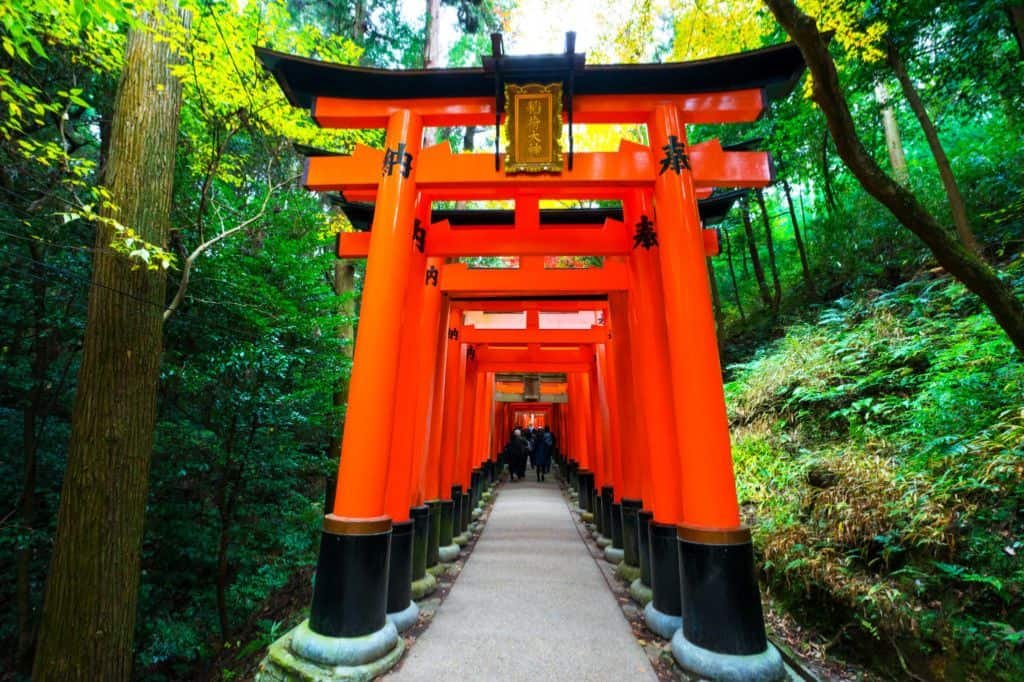
Fushimi Inari Taisha is instantly recognizable for its thousands of vermilion torii gates that create a winding path up Mount Inari. This Shinto shrine, dedicated to the god of rice and prosperity, is guarded by fox statues believed to be the deity’s messengers. As you ascend, you’ll pass smaller shrines, stone lanterns, and forested trails that offer a peaceful escape from the city. Hiking to the summit takes about two to three hours, but even a short walk through the lower gates is unforgettable. For the best photographs, visit early in the morning or late in the evening when the paths are less crowded and the light filters beautifully through the gates.
3. Kiyomizu-dera Temple
Kiyomizu-dera is one of Kyoto’s most celebrated temples, best known for its vast wooden stage that juts out from the main hall, offering sweeping views over the city. Built without the use of nails, this architectural marvel stands amid a hillside, surrounded by seasonal beauty—pink cherry blossoms in spring and fiery maple leaves in autumn. Beyond its visual charm, Kiyomizu-dera holds deep cultural significance as a place of pilgrimage and prayer. After exploring the temple grounds, visitors can wander down the charming Ninenzaka and Sannenzaka streets, lined with traditional shops selling crafts, snacks, and souvenirs.
Read More: Things to Do in Jeju Island
4. Arashiyama Bamboo Grove & Togetsukyo Bridge
A stroll through Arashiyama’s Bamboo Grove feels almost otherworldly, as towering stalks sway gently overhead and sunlight filters through the dense greenery. This serene path leads to one of Kyoto’s most picturesque landmarks, Togetsukyo Bridge, which spans the Katsura River against a backdrop of forested hills. The area is especially beautiful during the cherry blossom season and the autumn foliage. Nearby, visitors can explore Monkey Park Iwatayama for panoramic views of Kyoto, or visit the historic Tenryu-ji Temple, a UNESCO World Heritage site with exquisite gardens.
5. Gion District
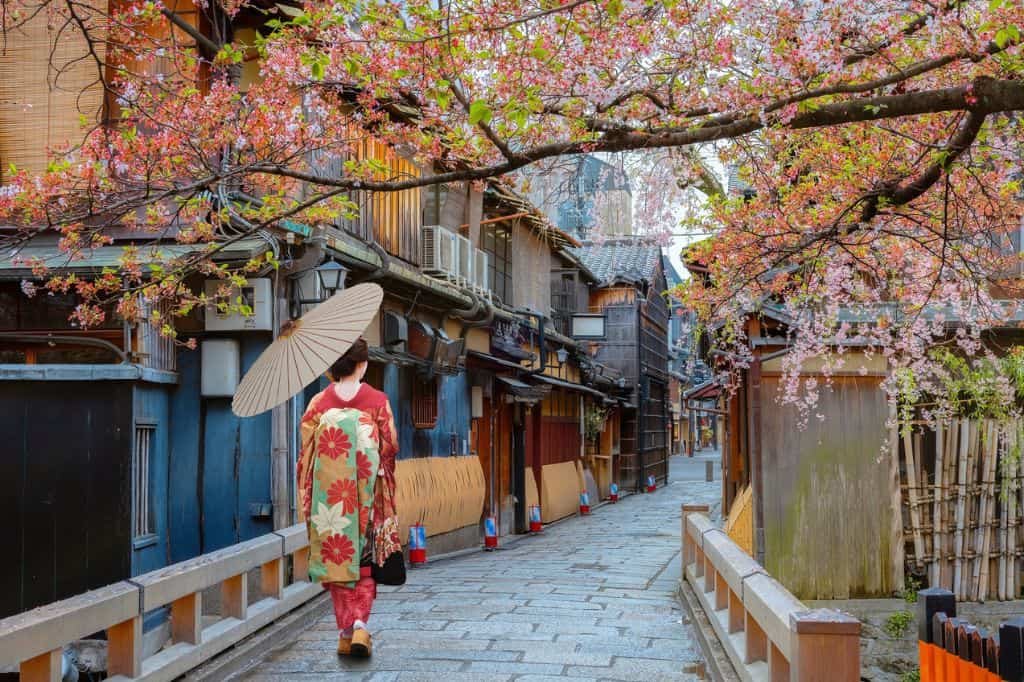
Gion is Kyoto’s iconic geisha district, where traditional wooden machiya houses and teahouses preserve the city’s old-world charm. In the early evening, lantern-lit streets create a magical atmosphere, and you may catch a glimpse of a geiko or maiko heading to an appointment. The district is also a hub for Kyoto’s renowned kaiseki cuisine, a multi-course dining experience that celebrates seasonal ingredients. Experiencing Gion at night is one of the most atmospheric things to do in Kyoto.
6. Philosopher’s Path
The Philosopher’s Path is a tranquil stone walkway following a cherry tree–lined canal in northern Kyoto. Named after a Kyoto University philosopher who walked this route for meditation, it offers a peaceful retreat from the city’s bustle. In spring, the cherry blossoms create a magical pink canopy, while autumn brings a warm palette of reds and golds. Along the way, you’ll find small temples, art galleries, and cozy cafés—perfect spots to pause and soak in the atmosphere. The path stretches between Ginkaku-ji (Silver Pavilion) and Nanzen-ji, making it an ideal route for a leisurely day of exploration.
Read Also: Things to Do in Iceland
7. Nishiki Market
Known as “Kyoto’s Kitchen,” Nishiki Market is a lively, covered street lined with over a hundred stalls selling everything from fresh seafood to pickled vegetables and traditional sweets. It’s the perfect place to sample Kyoto specialties like yuba (tofu skin), matcha treats, and skewered grilled fish. The market also offers unique souvenirs, including artisanal knives and handcrafted tableware. To avoid the biggest crowds, visit in the morning or on weekdays. Many stalls offer free samples, making it a delicious way to learn about the city’s food culture.
8. Nijo Castle
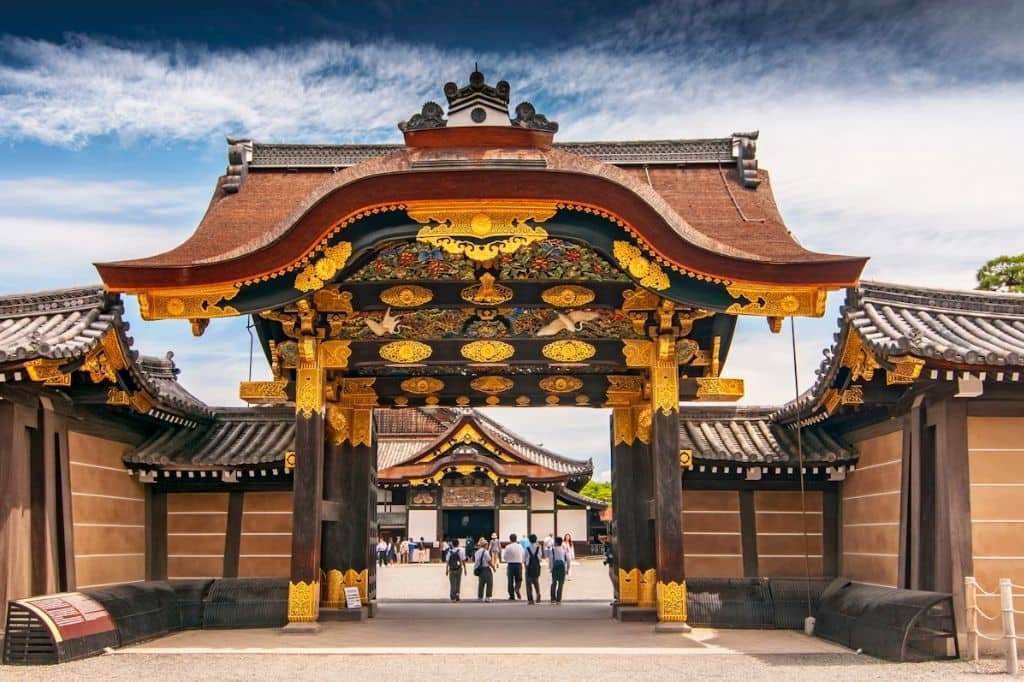
Nijo Castle stands as a grand reminder of Japan’s feudal era, once serving as the Kyoto residence of the Tokugawa shoguns. The castle is renowned for its “nightingale floors,” which chirp when stepped on to alert guards of intruders. Inside, you’ll find ornate sliding doors and tatami rooms that reflect the shogunate’s power. The gardens are spectacular during cherry blossom season and autumn foliage, making it a must on any things to do in Kyoto list.
9. Kyoto Imperial Palace & Gardens
The Kyoto Imperial Palace served as Japan’s imperial residence until the capital moved to Tokyo in 1869. Surrounded by expansive grounds, the palace complex features elegant wooden structures, intricately painted sliding doors, and carefully maintained gardens. Guided tours, available in multiple languages, offer fascinating insights into the imperial family’s history and court traditions. Even without a tour, the surrounding Kyoto Gyoen National Garden is open to the public year-round, providing a peaceful setting for leisurely walks among seasonal flowers and shaded paths.
Also Read: Free Things to Do in Philadelphia
10. Attend a Traditional Tea Ceremony
Experiencing a tea ceremony in Kyoto offers a glimpse into one of Japan’s most treasured cultural practices. In an intimate tatami room, a host carefully prepares and serves matcha, following precise movements that reflect centuries-old etiquette. Guests learn about the philosophy of harmony, respect, purity, and tranquility while enjoying seasonal sweets that complement the tea’s flavor. Many tea houses near Gion, Higashiyama, and temple districts welcome visitors, offering both short introductions and full-length ceremonies for a deeper experience.
11. Ginkaku-ji (Silver Pavilion)
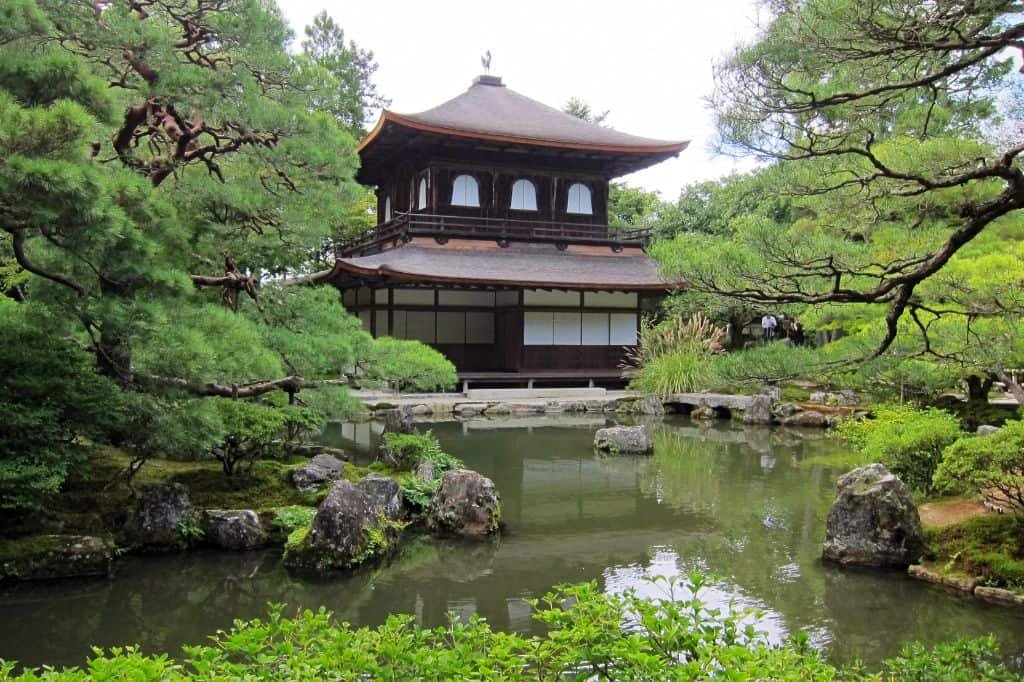
Ginkaku-ji, or the Silver Pavilion, is a Zen temple celebrated for its understated beauty and meticulously designed gardens. Despite its name, the structure was never covered in silver, which gives it a unique, subtle elegance. Visitors can stroll through moss gardens, raked sand landscapes, and scenic hillside paths with city views. This spot is especially tranquil in the early morning and is located at the northern end of the Philosopher’s Path, making it easy to combine with a day’s walk.
12. Ryoan-ji Temple
Ryoan-ji is home to Japan’s most famous rock garden, a masterpiece of Zen design. The rectangular bed of white gravel features fifteen carefully placed rocks, whose arrangement invites meditation and personal interpretation. Surrounded by maple and cherry trees, the temple grounds offer seasonal beauty that contrasts with the minimalist garden. Visiting in quieter hours enhances the meditative experience, allowing time to reflect on the garden’s mystery.
13. Kyoto Railway Museum
For train enthusiasts and families alike, the Kyoto Railway Museum offers an interactive journey through Japan’s rail history. Exhibits include vintage steam locomotives, shinkansen (bullet train) carriages, and hands-on simulators. The museum also features an observation deck overlooking active train lines, perfect for photography. Its central location makes it an easy addition to a day of sightseeing in western Kyoto.
Read More: Free Things To Do in Charlotte
14. Pontocho Alley
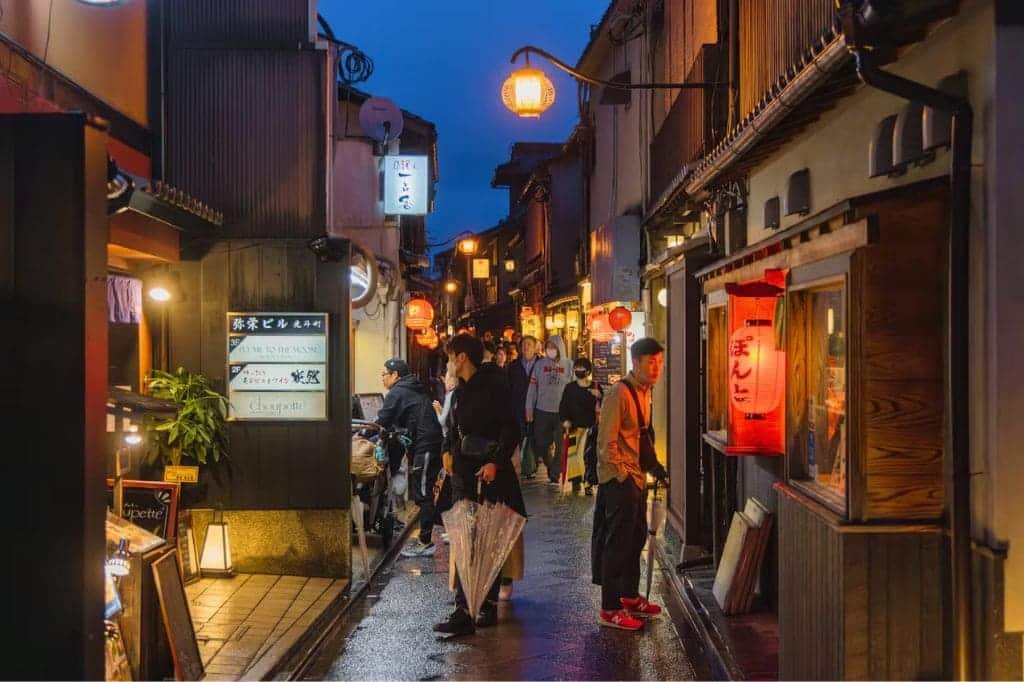
Pontocho Alley is a narrow lane along the Kamogawa River, famous for its intimate dining and nightlife. As evening falls, lanterns illuminate traditional wooden facades, creating a romantic atmosphere. Many restaurants offer kaiseki dining, yakitori grills, or river-facing terraces in summer. It’s also one of the best areas to spot geiko and maiko as they make their way to engagements.
15. Kyoto International Manga Museum
The Kyoto International Manga Museum houses one of the world’s largest manga collections, with shelves stretching across the building’s walls. Visitors can browse and read from thousands of volumes, including rare editions and translations. The museum also hosts exhibitions on manga history and culture, making it a must-visit for fans of Japanese pop culture.
16. Heian Shrine & Garden
Heian Shrine is famous for its giant torii gate and spacious gardens filled with seasonal flowers. The springtime cherry blossoms here are especially stunning, and the tranquil ponds make it a great place for a relaxing break.
17. Explore Hidden Machiya Townhouses
Kyoto’s machiya, or traditional wooden townhouses, offer a glimpse into local life from centuries past. Some have been converted into cafes, galleries, or guesthouses, allowing visitors to experience Kyoto’s living history in a personal way.
Read More: Cherry Blossom Season in Japan
Travel Tips for Kyoto
Best Transportation Options
Kyoto’s buses, subway lines, and rental bicycles make getting around easy. Many attractions are best explored on foot.
How to Avoid Crowds at Popular Sites
Visit major attractions early in the morning or late in the afternoon. Weekdays tend to be quieter than weekends.
Etiquette for Temples and Shrines
Be respectful—remove shoes where required, avoid loud conversation, and never touch sacred objects.
Recommended Passes and Tickets
Consider the Kyoto City Bus & Subway Pass or the JR Kansai Area Pass for affordable and convenient travel.
Suggested Itineraries
1-Day Quick Highlights
Start early at Fushimi Inari Taisha, then head to Kiyomizu-dera Temple and walk through Higashiyama’s historic streets. Enjoy lunch in Gion before visiting Kinkaku-ji and ending the day at Arashiyama Bamboo Grove.
3-Day Cultural Immersion
Day 1 covers the highlights above. Day 2 focuses on Southern Kyoto—Tofuku-ji, Byodo-in in Uji, and tea experiences. Day 3 includes temples like Ryoan-ji, Nanzen-ji, and seasonal gardens, finishing with a Noh or Kabuki performance.
5-Day In-depth Kyoto Exploration
Combine the 3-day itinerary with day trips to Nara and Himeji Castle. Use the extra time to explore hidden temples, take part in cultural workshops, and enjoy Kyoto’s evening illuminations.
You can Read: Nintendo Museum Kyoto
FAQs about Things to Do in Kyoto
How many days should I spend in Kyoto?
Three to four days is ideal for experiencing Kyoto’s main attractions, cultural experiences, and seasonal highlights without feeling rushed.
What is the best time of year to visit Kyoto?
Spring (March–April) for cherry blossoms and autumn (November) for foliage are the most scenic seasons, but Kyoto offers beauty year-round.
Is Kyoto walkable for tourists?
Yes. Many key attractions are within walkable historic districts, though buses and trains are useful for reaching sites farther apart.
What food is Kyoto famous for?
Kyoto is known for kaiseki (multi-course dining), matcha desserts, yuba (tofu skin), seasonal vegetables, and traditional sweets called wagashi.
Are there free things to do in Kyoto?
Yes. Strolling through Gion, walking the Philosopher’s Path, visiting free-entry shrines, and enjoying seasonal festivals cost nothing.
Conclusion
Kyoto remains a city where ancient traditions and modern comforts coexist in perfect harmony. Its grand temples, tranquil gardens, charming districts, and seasonal festivals ensure every visit feels unique. Beyond the world-famous landmarks, the many things to do in Kyoto include wandering hidden streets, discovering small shrines, and sampling dishes at local eateries that invite deeper exploration. Whether you have one day or a week, Kyoto offers a rhythm that balances busy sightseeing with moments of quiet reflection. Plan your journey to savor both its iconic sights and lesser-known treasures, and you’ll carry home memories that last a lifetime.


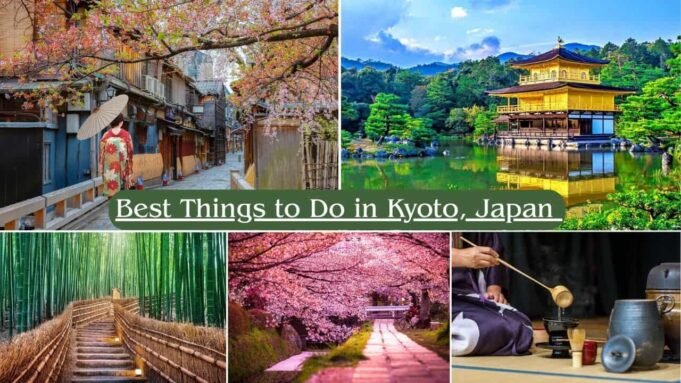


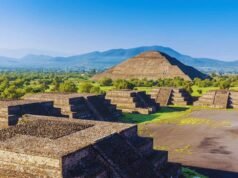










[…] Related: Best Things to Do in Kyoto […]
[…] Read More: Best Things to Do in Kyoto, Japan […]
Comments are closed.